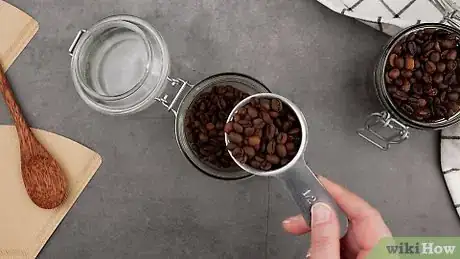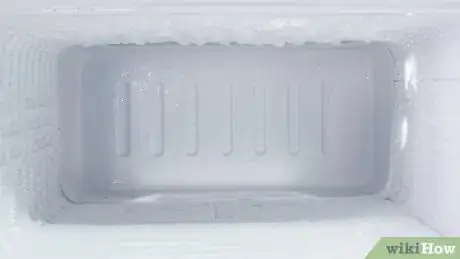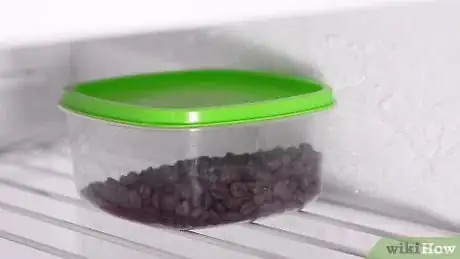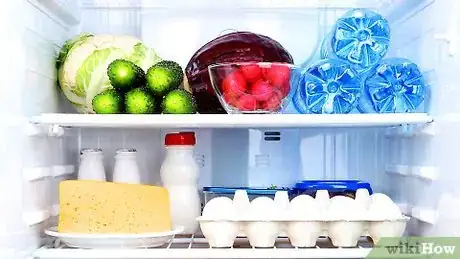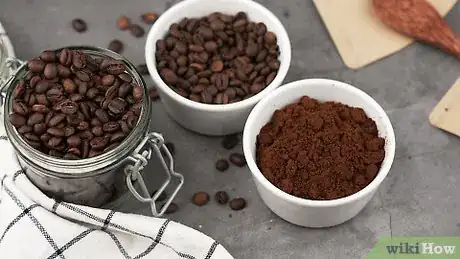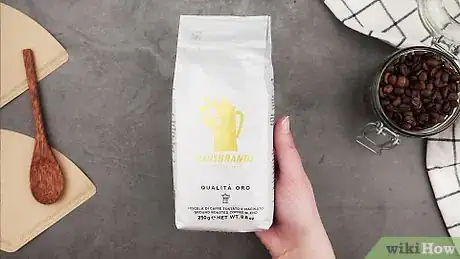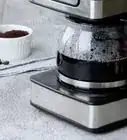This article was co-authored by Rich Lee. Rich is the Coffee & Food Program Director of Spro Coffee Lab in San Francisco, a California-based company that specializes in craft coffee, experimental mocktails, and culinary food science. Together with his team, Rich strives to bring forth a uniquely transcendent experience, free of stereotypical eats and drinks. Prior to owning his own business, Rich was a barista for big name coffee retailers such as Blue Bottle Coffee and Sightglass.
wikiHow marks an article as reader-approved once it receives enough positive feedback. In this case, several readers have written to tell us that this article was helpful to them, earning it our reader-approved status.
This article has been viewed 85,661 times.
It is important to store coffee properly so that it stays fresh and delicious for as long as possible. Coffee, in both whole bean and ground forms, deteriorates quickly when exposed to oxygen, light, moisture, and unfavorable temperatures. Coffee can also soak up odors from neighboring pantry items and then these odors will get transferred to your brewed cup of coffee. You can avoid these problems by storing coffee beans or ground coffee in an opaque, airtight container in an area that is not too moist and has a constant temperature.[1]
Steps
Storing Coffee at Room Temperature
-
1Store your coffee in an airtight container. One of the biggest enemies of fresh-tasting coffee is oxygen. Exposure to the air causes coffee beans, and especially ground coffee, to go stale very quickly. Invest in an hermetically-sealed container made for storing coffee, or at least use a container with a heavy airtight lid.[2]
- Airtight containers are also ideal for preventing coffee from absorbing neighboring odors and discouraging insect and mold growth.
- Some common airtight containers you can use include canning jars, Tupperware, and Ziplock bags.
-
2Choose an opaque container. Light causes coffee beans and grounds to go stale quickly. This problem is easily remedied by storing it in an opaque container rather than a clear glass or plastic vessel.[3]
- There are a wide variety of airtight containers made of metal, ceramic, and opaque glass that are great for storing coffee.
- If you insist on storing your coffee in a transparent container, it is best to store the container away from light, for example in a pantry or cabinet.
Advertisement -
3Keep your coffee in a dry environment. You may not have a great degree of control over the moisture level in your kitchen pantry or cabinets, but remember that coffee will keep best in a dry environment. Try to avoid storing coffee beans in a damp basement or other area that is very moist.[4]
- If you do need to store coffee in a moist area, keep it really well sealed. Also, move it out of the area before opening the packaging, so the moisture doesn't get to the beans.
-
4Keep humidity and temperature conditions constant. It's important to keep coffee's temperature and humidity levels constant, so don't move it around to different areas of your home that have vastly different conditions. For instance, don't store it in a really warm cupboard and then move it to a cold basement. Coffee will rapidly deteriorate if storage conditions vary constantly.[5]
Freezing Coffee
-
1Use the freezer for long-term storage only. The moisture and temperature conditions in a freezer are not great for preserving coffee's freshness. This is also where coffee is most likely to absorb offensive smells from neighboring food items. However, if you have more coffee than you can use in a month, it's a good idea to freeze what you won't use.[6]
-
2Put coffee in completely airtight containers. This will minimize the chance of freezer smells and moisture getting to the coffee. In most cases, this will require you to transfer coffee out of its original packaging into a thick plastic bag or other container that will not allow air in.[7]
- You can even vacuum seal extra coffee before putting it in the freezer. This will ensure that the package is airtight and the coffee has minimal exposure to oxygen.[8]
-
3Keep coffee in a deep freeze. Coffee stays at its best when it is kept at constant temperature and humidity conditions. Because of this, keeping it in a deep freeze that has a constant temperature, versus a refrigerator freezer that is constantly being opened and closed, is better.[9]
- If you don't have a deep freeze, put coffee at the back of your refrigerator freezer, so its temperature stays as constant as possible.
-
4Brew the coffee immediately after taking it out of the freezer. As soon as you take your coffee out of the refrigerator or freezer, carbon dioxide will begin escaping at an accelerated rate, causing the coffee to oxidize. Since this will cause the coffee to lose flavor, it's best to grind or brew the beans as soon as you can.
- To get your coffee to 200 °F (93 °C), you may have to heat the water slightly hotter than normal to account for the heat loss when the hot water touches the frozen beans.
-
5Do not refreeze coffee. Once you have frozen coffee and thawed it out, don't freeze it again. This repeated change in temperature does not have a good effect on the coffee's taste.[10]
- Keep this in mind when packaging coffee up for freezing. Putting it in several smaller packages will allow you to take a small amount out at one time and leave some in the freezer undisturbed.
Avoiding Common Mistakes
-
1Don't store coffee in a refrigerator. The refrigerator can potentially expose roasted coffee to undesirable conditions. The fridge is a moist place, so the beans or grounds are likely to come into contact with moisture. It can also introduce unwanted smells into coffee.[11]
- If you are going to use the coffee you have within a few weeks, keep it at room temperature instead of putting it in the fridge.
-
2Avoid grinding your coffee in advance, if possible. As soon as coffee is ground, it begins deteriorating very quickly when exposed to air. Pre-ground coffee therefore tastes and smells much staler and less vibrant than coffee ground freshly before brewing.[12]
- If you are interested in storing your coffee to achieve optimal flavor, it's a good idea to invest in a coffee grinder so that you can grind coffee beans just before brewing.
-
3Buy small amounts of coffee. Aim to purchase your coffee in small quantities that will last you a week or 2. Buying as small amounts as possible will ensure that your coffee is fresh when you brew it.[13]
- Having to store large amounts of coffee will most likely lead to stale coffee, no matter how well you store it.
-
4Buy valve-sealed bags rather than vacuum-sealed bags. You can get fresher coffee in a valve-sealed bags than a vacuum-sealed bag. In general, coffee in valve-sealed bags is put into its packaging right after it has been roasted, while it takes a few days for vacuum-sealed coffee to get packaged.[14]
- Coffee off-gasses for 48 hours after roasting, so coffee in a vacuum-sealed bag has to sit outside of packaging for 2 days before it can be vacuum-packaged. However, coffee can be put directly into valve-sealed bags because the valve on the bag allows the gasses to escape.
Expert Q&A
-
QuestionShould you keep ground coffee in the fridge?
 Rich LeeRich is the Coffee & Food Program Director of Spro Coffee Lab in San Francisco, a California-based company that specializes in craft coffee, experimental mocktails, and culinary food science. Together with his team, Rich strives to bring forth a uniquely transcendent experience, free of stereotypical eats and drinks. Prior to owning his own business, Rich was a barista for big name coffee retailers such as Blue Bottle Coffee and Sightglass.
Rich LeeRich is the Coffee & Food Program Director of Spro Coffee Lab in San Francisco, a California-based company that specializes in craft coffee, experimental mocktails, and culinary food science. Together with his team, Rich strives to bring forth a uniquely transcendent experience, free of stereotypical eats and drinks. Prior to owning his own business, Rich was a barista for big name coffee retailers such as Blue Bottle Coffee and Sightglass.
Professional Barista No. Avoid storing coffee in the fridge since moisture from the fridge could get in the coffee and ruin it.
No. Avoid storing coffee in the fridge since moisture from the fridge could get in the coffee and ruin it. -
QuestionI've been storing my daily use coffee by rolling the resealable bag closed to force out the air, then putting it in an old bread bag, also rolled to force out air, then putting in cool cabinet. Is this good?
 Community AnswerThat should keep your coffee safe and fresh.
Community AnswerThat should keep your coffee safe and fresh. -
QuestionI store ground coffee in an airtight bag in the freezer. Will it also last three to five months?
 Community AnswerIt might last from seven to eight months, but the taste will be lost. If you store it as you mentioned, it should last up to half a year.
Community AnswerIt might last from seven to eight months, but the taste will be lost. If you store it as you mentioned, it should last up to half a year.
Things You'll Need
- Coffee beans or grounds
- Airtight, opaque container
- Cool, dark storage area
- Coffee grinder, if necessary
References
- ↑ http://www.ncausa.org/About-Coffee/How-to-Store-Coffee
- ↑ https://www.stumptowncoffee.com/pages/faq
- ↑ https://bluebottlecoffee.com/frequency/store-coffee
- ↑ http://www.ncausa.org/About-Coffee/How-to-Store-Coffee
- ↑ http://www.ncausa.org/About-Coffee/How-to-Store-Coffee
- ↑ https://bluebottlecoffee.com/frequency/store-coffee
- ↑ http://www.ncausa.org/About-Coffee/How-to-Store-Coffee
- ↑ https://thekitchenprofessor.com/blog/how-to-store-ground-coffee-long-term
- ↑ https://www.seriouscoffee.com/about-us/our-coffee/proper-coffee-storage/
About This Article
To store coffee beans or ground coffee at room temperature, place the coffee in an opaque container with a heavy, airtight lid so it will stay fresh longer. Place the container in a dry environment away from direct sunlight, and keep the humidity and temperature conditions constant. If you are freezing coffee for long-term storage, place it into a completely airtight container, then place it into a deep freeze if you have one, since they tend to maintain a constant temperature more than a kitchen freezer that is opened often. To learn more, such as how to use coffee after it's been frozen, keep reading the article!
